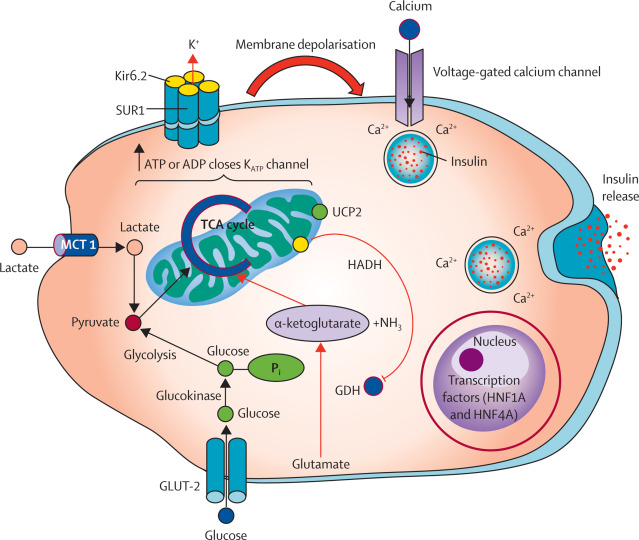Our official English website, www.x-mol.net, welcomes your
feedback! (Note: you will need to create a separate account there.)
Hyperinsulinaemic hypoglycaemia in children and adults.
The Lancet ( IF 98.4 ) Pub Date : 2017-09-01 , DOI: 10.1016/s2213-8587(16)30323-0 Pratik Shah , Sofia A Rahman , Huseyin Demirbilek , Maria Güemes , Khalid Hussain
The Lancet ( IF 98.4 ) Pub Date : 2017-09-01 , DOI: 10.1016/s2213-8587(16)30323-0 Pratik Shah , Sofia A Rahman , Huseyin Demirbilek , Maria Güemes , Khalid Hussain

|
Pancreatic β cells are functionally programmed to release insulin in response to changes in plasma glucose concentration. Insulin secretion is precisely regulated so that, under normal physiological conditions, fasting plasma glucose concentrations are kept within a narrow range of 3·5-5·5 mmol/L. In hyperinsulinaemic hypoglycaemia, insulin secretion becomes dysregulated (ie, uncoupled from glucose metabolism) so that insulin secretion persists in the presence of low plasma glucose concentrations. Hyperinsulinaemic hypoglycaemia is the most common cause of severe and persistent hypoglycaemia in neonates and children. At a molecular level, mutations in nine different genes can lead to the dysregulation of insulin secretion and cause this disorder. In adults, hyperinsulinaemic hypoglycaemia accounts for 0·5-5·0% of cases of hypoglycaemia and can be due either to β-cell tumours (insulinomas) or β-cell hyperplasia. Rapid diagnosis and prompt management of hyperinsulinaemic hypoglycaemia is essential to avoid hypoglycaemic brain injury, especially in the vulnerable neonatal and childhood periods. Advances in the field of hyperinsulinaemic hypoglycaemia include use of rapid molecular genetic testing for the disease, application of novel imaging techniques (6-[fluoride-18]fluoro-levodopa [18F-DOPA] PET-CT and glucagon-like peptide 1 (GLP-1) receptor imaging), and development of novel medical treatments (eg, long-acting octreotide formulations, mTOR inhibitors, and GLP-1 receptor antagonists) and surgical therapies (eg, laparoscopic surgery).
中文翻译:

儿童和成人的高胰岛素血症性低血糖症。
胰岛β细胞在功能上被编程为响应血浆葡萄糖浓度的变化而释放胰岛素。胰岛素分泌受到精确调节,因此在正常生理条件下,空腹血糖浓度应保持在3·5-5·5 mmol / L的狭窄范围内。在高胰岛素血症性低血糖症中,胰岛素分泌变得失调(即,与葡萄糖代谢无关),因此在血浆葡萄糖浓度低的情况下,胰岛素分泌持续存在。高胰岛素血症性低血糖症是新生儿和儿童严重和持续性低血糖症的最常见原因。在分子水平上,九种不同基因的突变可导致胰岛素分泌失调并引起这种疾病。在成年人中 高胰岛素血症性低血糖症占低血糖症病例的0·5-5·0%,可能归因于β细胞肿瘤(胰岛素瘤)或β细胞增生。快速诊断和及时处理高胰岛素血症性低血糖对于避免低血糖性脑损伤至关重要,尤其是在脆弱的新生儿和儿童时期。高胰岛素血症性低血糖症领域的进展包括对该疾病的快速分子遗传学检测,新颖的成像技术(6- [fluoride-18] fluoro-levodopa [18 F-DOPA] PET-CT和胰高血糖素样肽1(GLP-1)受体显像),以及新型医学治疗方法的开发(例如长效奥曲肽制剂,mTOR抑制剂和GLP-1受体拮抗剂)和外科手术治疗(例如,腹腔镜手术)。
更新日期:2017-08-10
中文翻译:

儿童和成人的高胰岛素血症性低血糖症。
胰岛β细胞在功能上被编程为响应血浆葡萄糖浓度的变化而释放胰岛素。胰岛素分泌受到精确调节,因此在正常生理条件下,空腹血糖浓度应保持在3·5-5·5 mmol / L的狭窄范围内。在高胰岛素血症性低血糖症中,胰岛素分泌变得失调(即,与葡萄糖代谢无关),因此在血浆葡萄糖浓度低的情况下,胰岛素分泌持续存在。高胰岛素血症性低血糖症是新生儿和儿童严重和持续性低血糖症的最常见原因。在分子水平上,九种不同基因的突变可导致胰岛素分泌失调并引起这种疾病。在成年人中 高胰岛素血症性低血糖症占低血糖症病例的0·5-5·0%,可能归因于β细胞肿瘤(胰岛素瘤)或β细胞增生。快速诊断和及时处理高胰岛素血症性低血糖对于避免低血糖性脑损伤至关重要,尤其是在脆弱的新生儿和儿童时期。高胰岛素血症性低血糖症领域的进展包括对该疾病的快速分子遗传学检测,新颖的成像技术(6- [fluoride-18] fluoro-levodopa [18 F-DOPA] PET-CT和胰高血糖素样肽1(GLP-1)受体显像),以及新型医学治疗方法的开发(例如长效奥曲肽制剂,mTOR抑制剂和GLP-1受体拮抗剂)和外科手术治疗(例如,腹腔镜手术)。











































 京公网安备 11010802027423号
京公网安备 11010802027423号